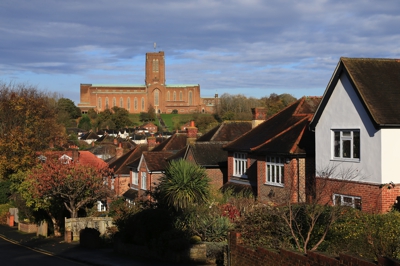History
 The diocese of Guildford is a new one, dating from 1927. At that time the incumbent bishop didn’t actually have a cathedral in which to sit, with work not commencing until the foundation stone was laid in 1936.
The diocese of Guildford is a new one, dating from 1927. At that time the incumbent bishop didn’t actually have a cathedral in which to sit, with work not commencing until the foundation stone was laid in 1936.
What should have been steady progress with the construction was abruptly halted by the Second World War. Wartime shortages and other commitments meant that construction did not resume until the 1950’s when Miss Eleanor Iredale launched a ‘buy-a-brick’ campaign to encourage local people to become involved in the project.
At half-a-crown per brick (12.5p) more than 200,000 people contributed to the construction fund and, through this early example of what we might now call ‘cloud-funding’ they enabled the cathedral to be completed and consecrated by 1961. One of these bricks, donated by HM Elizabeth II, still bears her signature. Such was the public enthusiasm for the cathedral that 1500 kneelers were also hand-made by local supporters.
Since its consecration the cathedral has played a central role in Guildford, far beyond being just a place of worship. The University of Surrey holds its graduation ceremonies there, it has featured in films, it plays host to international and local concerts and a to a programme of art exhibitions amongst other roles.
Visiting the Cathedral
Cathedral Building
Visitors are welcome to explore the cathedral and admire the contemporary architecture. Although there are very few stained-glass windows, the structure makes good use of light, and where stained glass does exist, it often produces impressive coloured light displays on the light walls.
Visitors can obtain advice and information about the building, and be directed to the free ‘self-guide’ leaflets, that enable visitors to tour the cathedral and its ground at their own pace, from any of the volunteer ‘greeters’ on duty in the cathedral. This is a good starting point if you want to know more about the building.
Treasury
For a thoroughly modern cathedral, the treasury contains an impressively varied collection of silver plate, alms plates, chalices, flagons and other ecclesiastical items collected from local parishes, ranging from a bronze thurible cover (a container for burning incense) from the twelfth through to a thoroughly modern silver-gilt ciborium – the container used to hold the wafers used in Holy Communion.
Library
The library consists of the Theological Library, based within the cathedral, and the Resource Centre, housed in the adjacent Education Centre. Most of the books are modern publications covering Christian ethics, church history and Biblical commentaries.
Archives
The Archives contain material relating to the cathedral, covering the period from its origins in 1932 through to the modern day. Letters, photographs, CD and DVD collections are available in addition to the usual collection of Registers.
Opening Hours and Costs
The Cathedral-
Please check official website for opening times and closures for special events.
Guided Tours:
Must be arranged in advance and includes a nominal fee.
The Treasury-
Please check official website for opening times. Admission is free.
Note: The Cathedral is normally open 365 days a year, but may close to visitors during some specific events such as concerts, graduation ceremonies and when building maintenance would create a safety risk to visitors.
